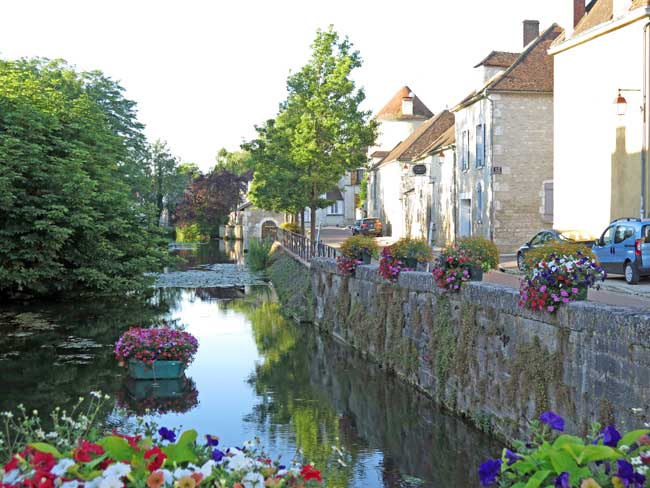
Sunday, 28 June 2015
Distance 24 km
Duration 5 hours 30 minutes
Ascent 250 m, descent 260 m
Map 128 of the TOP100 lime-green series
Our German dentist friend drove off with a jolly wave while we were still packing up, so it was quite a surprise to see him again when we finally got moving.
He was stuck inside the barrier, not looking nearly as jolly, and the manager was trying to convince him that he had never entered in the first place, which seemed a rather fine philosophical point, given his position.
We left them to it, ducked under the barrier and meandered off across the water meadows to town.
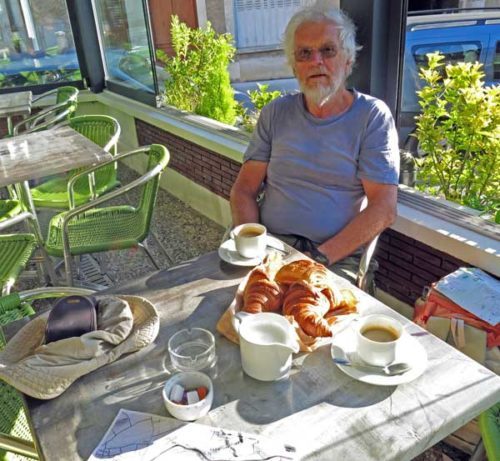
Picking up some croissants on the way, we went into the Chablis Bar for the third and last time – it was the only one open, and even it was hard to get into, because a market was being set up in the street outside.
The sun poured in at the window, promising a hot day later, but at this hour it was lovely. The pastries were exceptionally light and flaky, yet filling, and the coffee diffused into our veins in the most delightful way.
Our plan was to walk out on the main road to the west (the D235) and look for GR signs, which must surely appear at some stage. After all, that was the way the GR used to go.
It was a suburban trudge as far as the roundabout where the ring road came in (the ring road that we had foolishly followed yesterday) and immediately after that we left the highway at the village of Poinchy.


Guided by a hazy memory of our previous walk, we went past the church, with its stone garden of graves at the front, past the war memorial, past some new houses and out into the vines.
The little road started to climb but when we got to a wide farm track going off between the vines, we remembered that this was the old GR.
It continued on a level course across the slope, with vines above and below, being fussed over by their minder (the question arises – who is in charge here, the humans or the vines? Who has enslaved whom?)
After a quarter of an hour the track began to descend and we saw the waters of the lake of Beine reflecting the green hillside beyond.


At this point we suddenly saw a GR sign on a track coming up the slope. (Later we found out that the GR had wandered off from Chablis through the village of Milly and over a ridge before rejoining its old path.)
As we passed the lake there were Sunday morning fishermen sitting under the willows on the grassy bank, the personification of serenity.
Just after that we reached the first houses of Beine and realised that we were back on our maps – the little road coming down to join ours was the one we would have taken from Ligny-le-Châtel.

It was now 9:30 am, a couple of hours since we had last occupied a bar, and we were looking forward to the one on the highway at Beine which had given us such a pleasant surprise last time. It gave us a surprise again, but this time not so pleasant – it was closed and looked dead.
Rising above our disappointment, as so often before, we continued our westward progress, but not on the GR. We had seen an easier way, a farm track followed by a short section of highway (absolute anathema to the GR designers).
The highway had a wide verge and hardly any traffic, and we soon reconnected with the GR. The land was getting hillier and there were fewer vines. Instead there were great swathes of wheat punctuated by patches of dark forest.

Near the tiny settlement of Haut Soleine we took further liberties with the GR and saved ourselves a good bit of road-bashing by taking a path up through the wheat to the village of Venoy.
Once again we thanked our home-made maps, which showed all these tracks.
Having crossed the autoroute on an overbridge, we pressed on through the fields.
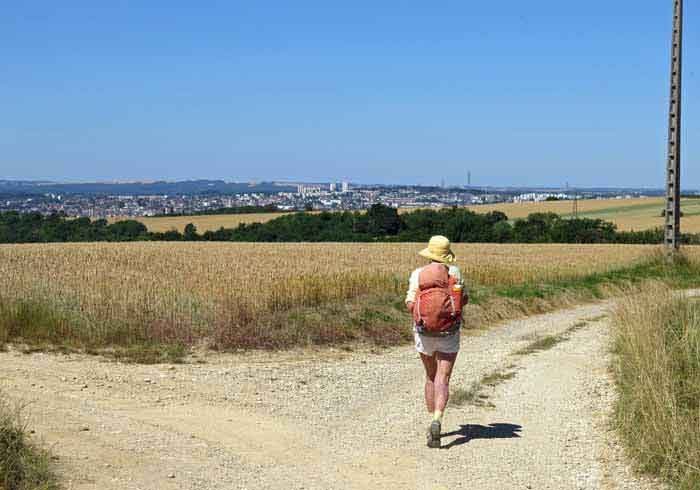
There were several tracks going off but we were being very careful, because this was where we had made a big mistake last time and ended up lost in a tree-choked riverbed.
We made sure that we did not turn until we saw the actual GR turning sign, just before some high-tension power lines.
After that we cruised down the golden hillside with no trouble at all, and quickly found ourselves on a road, which passed over a large ring road (the N6) and into the top streets of Auxerre.

It was after midday by this time and we were getting hot and thirsty, so we decided to visit the railway station on our way past. Just outside it we went into a bar, but came straight out again – it was hot and stuffy and reeked of cigarettes. (We only noticed the other bar further along, with its tables set out pleasantly under the trees, as we emerged from the station later.)
Inside the station it was cool and comfortable, but the brasserie was closed. The only refreshments were from vending machines, one of which dispensed cold drinks.
The bad news was that they cost €2 each and we only had a single €1 piece, apart from paper money. Then we saw another machine that offered coffee in a little plastic cup for €1, so we got one of those and shared it with great enjoyment.
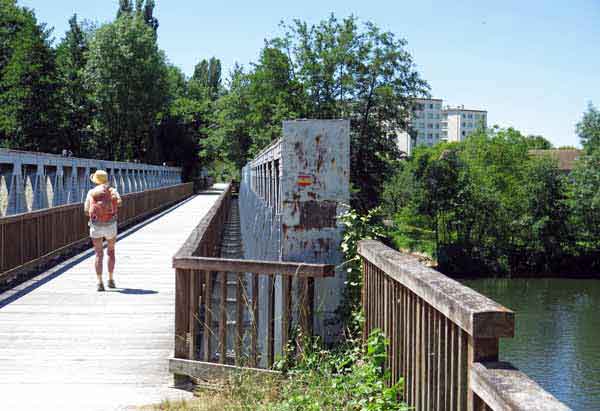
Setting off again for the last leg of the day’s walk (or so we thought), we crossed the river on an abandoned railway bridge, high above an expanse of sports fields.
Once over the river we clambered down some steps and went along the road to the camping ground, which was opposite the stadium.
We remembered it fondly from our previous visit, but this time there was trouble. The woman in the office, looking red-eyed and distracted, announced that we could not stay there.
A music festival was in progress and nobody had slept since Thursday – she herself was about to go mad.
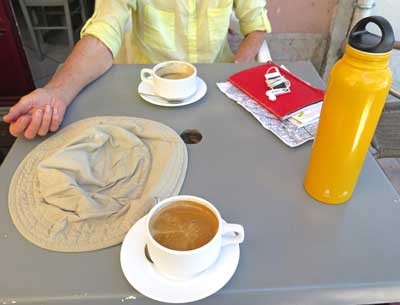
Meanwhile several caravans and camping cars had arrived and been directed to the camping ground at Vincelles, ten kilometres down the canal. Obviously that was not much of an option for us, so she kindly rang up the Maison des Randonneurs in the middle of town (which we had never heard of) and booked us in. The only condition was that we could not arrive until 4 pm.
Casting a look of hatred at some passing bare-footed, dread-locked musicians, she gave us a town map and sent us back the way we had come. It was a couple of kilometres that we did not feel like doing, but we ended up on the spacious riverbank near a footbridge, and installed ourselves in a café where everyone except us was having lunch. They all seemed to be tourists at this hour (it was after 2 pm).
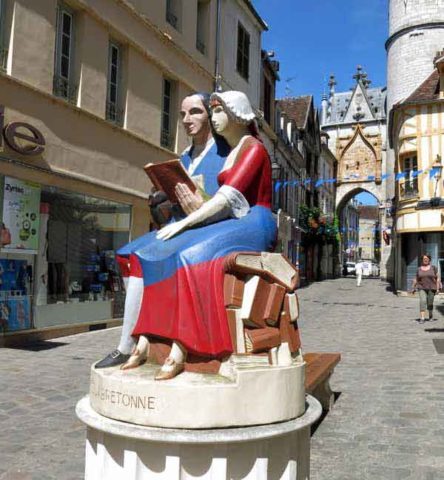
We stayed there in the shade as long as we could, sustained by coffee and cold water. It was comfortable enough but at half past three we were really sick of the place and set off to walk slowly towards our accommodation.
The old part of Auxerre is on a steep knoll and is the usual picturesque, disorganised network of lanes. The most spectacular part of it is the golden clock on an archway straddling the street, part of the mediaeval defensive walls of the town, This archway was destroyed by fire in the nineteenth century, but quickly rebuilt.
A few steps away, a famous son of Auxerre is commemorated by a statue – the writer Restif de la Bretonne, born nearby in 1734. According to a later critic, he was “inordinately vain, and of extremely relaxed morals . . . making his books quite unfit for general perusal”. However the statue refers to an innocent event recounted by Restif, when a young girl came to read over his shoulder at this spot.

Across the street from Restif was another statue of a long-forgotten writer, the poetess Marie Noël, who was also a native of Auxerre. She is depicted as a simple countrywoman with shawl and basket. It was impressive to see how the community was honouring these otherwise obscure local heroes.
Having done our bit for tourism, and with the aid of the map supplied by the camping woman, we made our way to the Maison des Randonneurs, which was an old house with a big park behind it. It had been the home of Paul Bert, who was evidently someone very famous, since we had already seen a street and a bridge named after him.
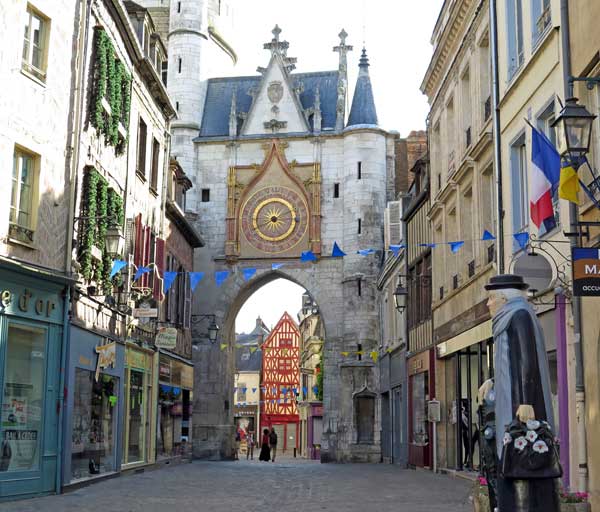
We discovered later that he was a doctor, a scientist and a fiery politician, born in Auxerre in 1833. He was a radical reformer and his passion was to remove education from the clutches of religion and make it free to all children. We liked the sound of him.
A dithery woman opened the door, took our €36 and showed us to our room on the first floor, looking out on the treetops of the park.
There was a kitchen below but we had no intention of using it – we were off to town for dinner. But first we had showers and a little rest on our bunk beds.
Other visitors arrived but they came by car and lugged huge suitcases with them, which was slightly amazing given that it was supposed to be a walkers’ hostel.

At about 7 pm we set off up the Rue Paul Bert to the top of town. Our destination this time was the Place des Cordeliers, a great sloping expanse surrounded by fine old buildings, most of them now bars or restaurants.
Under the combined green shade of umbrellas and plane trees, Keith had pastis and I was given the choice of a faintly tinted rosé from Sancerre and a darker Burgundian one. I chose the latter to support the local industry.
Then our host came around with a basket full of choux pastry puffs, hot from the oven, and we had two each, perhaps a little greedily.

After a while we strolled down to inspect the dining possibilities. Only one restaurant had an outdoor terrace and it was very crowded, but we saw a vacant table and after an undignified scramble, we managed to reach it before it was taken.
The rest of the evening was a complete pleasure. The air was warm, with a slight breeze – at last we had no need to bring socks and jackets with us at night.
We began by sharing a plate of charcuterie, a delicious array that would have made an excellent lunch, and since we had missed lunch, we felt that we were just catching up. Nevertheless, two puffy bread buns stuffed with ham disappeared into my ever-ready bag.
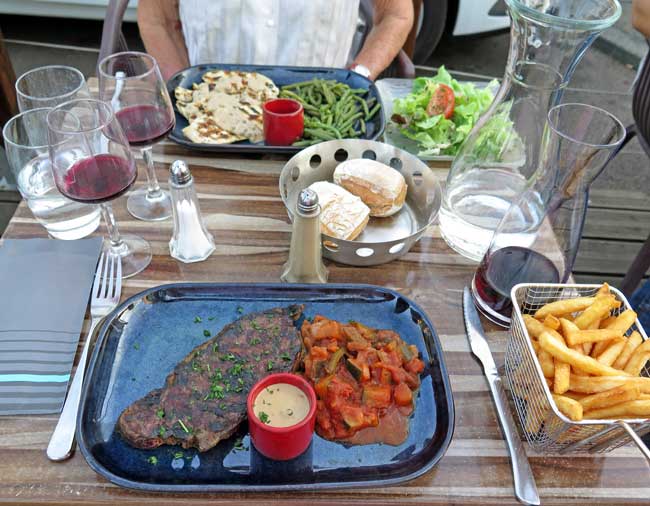
The main course was equally delicious. Keith had steak with ratatouille and I had charred chicken with green beans and salad, both accompanied by that king of sauces, green peppercorn.
As we worked our way through this feast we chatted with a group at the next table, four Norwegians who were on an organised bike ride through Burgundy, having their luggage transported between hotels.
They recommended that we try walking in Norway and we said we would definitely think about it (we will, one day).
Afterwards we strolled back down the Rue Paul Bert to the house, so much easier than trudging all the way to the camping ground. Sleeping on sheets was another luxury, with the window flung wide open to the sky.
Previous day: Tonnerre to Chablis